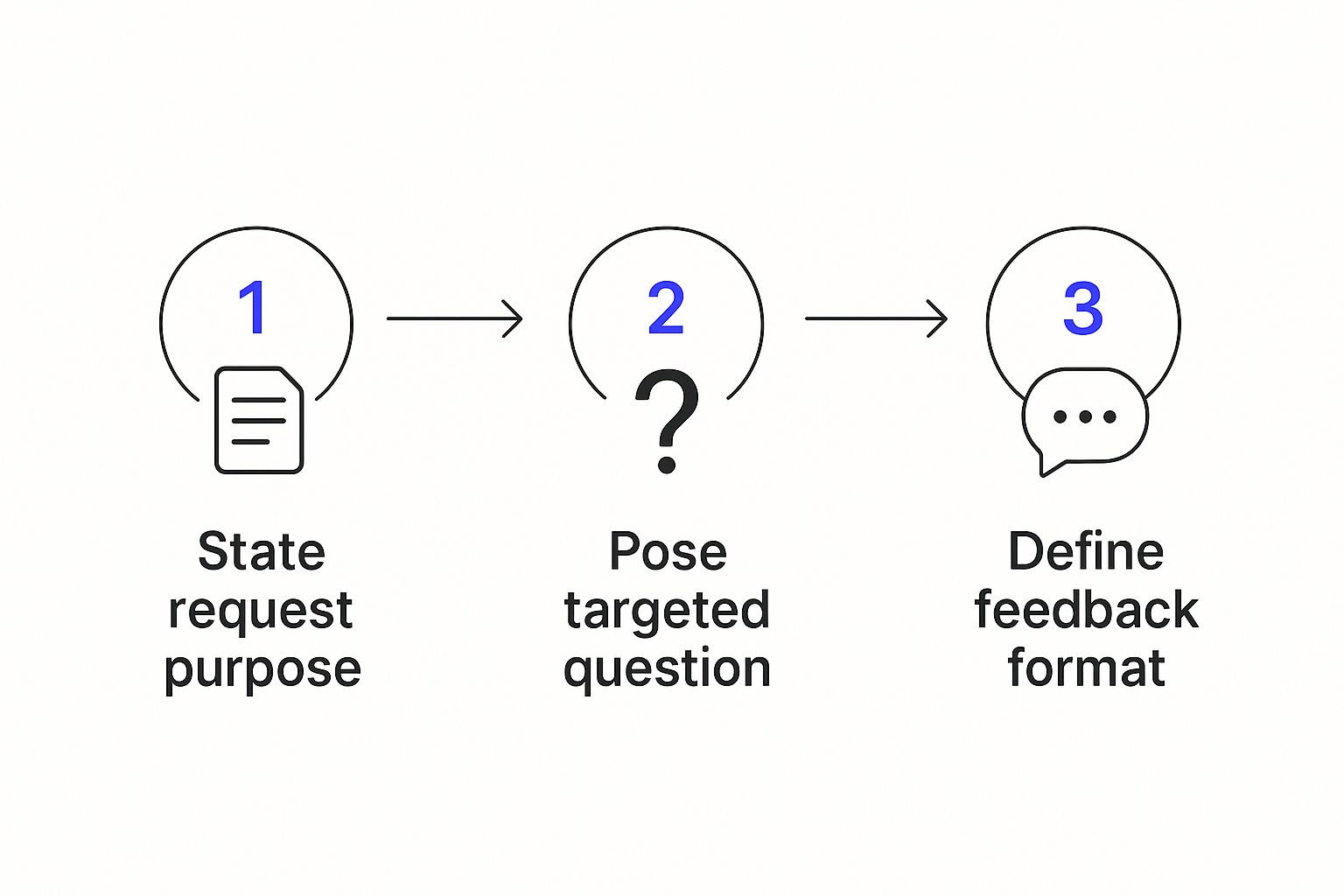How to Ask for Feedback and Get Great Results
Learning how to ask for feedback is all about making it incredibly easy for people to give you the good stuff—specific, constructive advice that you can actually use.
It’s a simple shift in mindset. Instead of dreading it, you start seeing feedback as your greatest tool for getting better at what you do. This means being crystal clear about your goals, asking the right questions, and catching the right person at the right time.
Why Asking for Feedback Is Your Career Superpower
Let's reframe how we think about feedback. It’s not about getting a list of everything you did wrong. It's a ridiculously powerful tool for hitting fast-forward on your career.
When you proactively ask for input, you’re not just refining your skills; you’re building stronger relationships and, frankly, producing much better work. Think about a junior designer who managed to double their project approval rate. How? By getting smarter about the questions they asked after each draft. That’s the kind of real-world impact we're talking about.
Bridge the Communication Gap
Here’s a wild disconnect for you: most people are starving for feedback, but very few are getting it.
Around 60% of employees wish they got feedback either daily or weekly, yet almost no one does. This desire is even stronger with younger folks in the workforce, which tells you there’s a massive, unmet need for more consistent input. When you learn how to ask, you stop waiting for that dreaded annual review and take control of your own growth.
By actively seeking input, you’re not showing weakness—you’re demonstrating a commitment to excellence that managers and colleagues respect.
Adopt a Growth Mindset
Making this a regular habit is a huge strategic advantage. It instantly signals that you're engaged, self-aware, and serious about improving.
To really get the most out of it, it helps to understand how your company approaches performance management best practices. Knowing the bigger picture helps you frame your requests in a way that aligns with team and company goals, making your feedback sessions even more effective.
Trust me, by the end of this guide, you’ll see that asking for feedback is one of the smartest moves you can make for your career.
Laying the Groundwork for Great Feedback

Let's be real—the difference between getting a vague "looks good!" and landing some truly game-changing advice almost always comes down to how you ask. Before you fire off that Slack message or email, a little bit of prep can completely transform the quality of the feedback you receive.
This isn’t about being stuffy or formal. It's about making it dead simple for people to help you. Everyone's busy, and a well-thought-out request shows you respect their time. That alone makes them far more likely to give you the detailed insights you’re actually looking for.
Pinpoint Your Goal
The most common mistake people make is being way too broad. A generic "What do you think?" is a direct invitation for an equally generic response. You have to get specific.
Think about what you're really questioning. Is it the high-level strategy or a tiny detail in a design? Getting clear on this is everything.
For example, instead of just sharing a link to a Google Doc, try framing your request like this:
- For big-picture feedback: "Does the overall structure of this proposal make sense for a brand new client?"
- For detailed feedback: "Is the chart on slide 7 easy to understand, or does it need a better explanation?"
- For user experience feedback: "When you first look at this landing page mockup, where does your eye go?"
This kind of specificity acts like a guide, pointing your reviewer's attention exactly where you need it most.
When you frame your request around a specific problem, you change the dynamic. It stops being about a simple "good" or "bad" judgment and becomes a collaborative problem-solving session.
Give Them the Context They Need
Never, ever assume the person you're asking knows the full backstory. Dropping a link into a chat with zero context is a surefire way to get confused, low-effort feedback.
A little background goes a long, long way.
Whip up a few bullet points—or even a quick one-pager—that covers the project's main objective, who the target audience is, and any weird constraints you're dealing with. This simple step ensures they understand what you're trying to do before they start picking apart how you did it. Giving them this frame of reference makes their feedback instantly more relevant and genuinely helpful.
Finding the Right Person and the Right Moment

The feedback you get is only as good as who you ask and when you ask them. It's easy to default to your manager, but the real magic happens when you build your own personal "board of advisors." Getting different viewpoints is the key to seeing your work from all angles.
Think beyond your direct reporting line. Your peers are right there in the trenches with you; they'll see technical hiccups or workflow snags a manager might overlook. A mentor, on the other hand, can give you that 30,000-foot view and connect your work to your broader career goals. And don't forget colleagues in other departments—they're your best bet for figuring out if your message actually makes sense to the rest of the company.
A diverse feedback circle is your best defense against blind spots. Someone from another team brings fresh eyes, catching things you and your immediate colleagues have gotten used to seeing.
Choosing Your Feedback Source
Different people offer different kinds of value. The trick to getting truly useful feedback is matching your question to the right person.
Before you send that message, take a second to think about what you really need.
- A Peer or Teammate: Go to them for the nitty-gritty stuff. They’re perfect for feedback on technical execution or internal processes.
- A Mentor or Senior Colleague: This is where you go for big-picture thinking, strategic advice, and making sure your work aligns with your career path.
- A Cross-Functional Colleague: Need to know if your project makes sense to someone outside your bubble? Ask them. They’re great for checking clarity and impact.
- Your Manager: They’re essential for making sure you're aligned with team goals, performance expectations, and project priorities.
Building these relationships is a skill in itself. For some extra tips on connecting with the right people, check out our guide on effective strategies for job search networking.
Identifying the Right Moment
Timing is everything. A brilliant request sent at a terrible time is just going to get ignored or receive a rushed, half-hearted reply. You have to respect their schedule.
Don't ambush someone in the hallway or drop a massive request in their lap at 4:00 PM on a Friday. That’s a recipe for disaster.
Instead, be strategic. A low-pressure message that proposes a quick 15-minute coffee chat or a scheduled video call shows you value their time and came prepared. This simple courtesy makes it way more likely they'll give you their full attention, which leads to much better, more thoughtful feedback.
How to Frame Your Feedback Request
Ever ask "What do you think?" only to get a shrug and a "Looks good"? We've all been there. The hard truth is, the quality of the feedback you get is a direct reflection of the quality of the question you ask.
If you want truly constructive, detailed advice, you have to move beyond lazy, open-ended questions. It’s about guiding the reviewer's attention right where you need it most, turning a vague ask into a targeted mission for them.
The process is actually pretty straightforward. Think of it in three parts: state your purpose, ask a super-specific question, and tell them what kind of feedback you're looking for.

This simple flow—purpose, question, format—takes the guesswork out of it for the other person and ensures you get something you can actually use.
From Vague to Valuable
Let's make this real. Say you've just polished your resume and need a fresh pair of eyes. Asking a vague question won’t get you far, but a specific one can unlock game-changing insights. This isn't just for resumes; it works for project proposals, presentations, you name it.
The secret is giving your reviewer a specific problem to solve or a clear lens to look through. Don't make them do the hard work of figuring out what you need.
For a deeper dive on your resume, check out our guide on how to improve it here: https://www.eztrackr.app/blog/how-to-make-my-resume-better
A well-framed question shows you respect their time and have already put some real thought into what would be helpful. See how a few changes in phrasing can dramatically improve the quality of the feedback you receive.
Transforming Vague Requests into Actionable Ones
| Weak Request (Leads to Vague Answers) | Strong Request (Gets Specific, Actionable Advice) |
|---|---|
| "Can you look at my report?" | "Could you check the intro on my report? I'm worried it doesn't hook the reader in the first paragraph." |
| "Thoughts on this design?" | "Does this design feel cluttered, or is the information hierarchy clear enough to guide the user's eye?" |
| "Is this email okay?" | "Does the tone of this email sound professional but not too formal for a first-time client?" |
Notice how the strong requests give the reviewer a clear job to do? This focused approach is essential in so many professional situations, much like when you're requesting a letter of recommendation, where clarity and purpose are everything.
Practical Examples for Email and Slack
How you ask for feedback will naturally change depending on where you're asking. Here’s how you can put this into practice in a couple of common scenarios.
- Email Request: "Hi Alex, I’ve attached the Q3 sales deck. When you have a moment, could you spend 15 minutes reviewing slides 5-7? I want to make sure the data visualization is clear and supports our main point about market expansion."
- Slack/Teams Message: "Hey team, quick look at this customer journey map when you have a free second? Specifically, does the 'Onboarding' phase accurately reflect the steps a new user actually takes?"
By getting specific about the what (slides 5-7), the why (ensure data is clear), and the how long (15 minutes), you make it incredibly easy for your colleagues to give you exactly the help you need. It’s a simple tweak that makes a world of difference.
Receiving Feedback and Turning It into Action
Getting the feedback is only half the battle. What you do next is what really sets you up for growth.
Let's be honest—hearing criticism can sting. The natural human reaction is to get defensive or start explaining why you did what you did. But the whole point of this exercise is to listen and understand, not necessarily to agree on the spot.
So, take a beat. Before you jump in to defend your choices, shift into a learning mindset. Try asking a few clarifying questions. This shows you're actually listening and that you respect their point of view, which goes a long way.
From Notes to Next Steps
Okay, you've gathered all this input. Now what? You're definitely not obligated to act on every single piece of advice you receive. The real skill here is spotting the patterns and making smart decisions about what to implement.
Start by sifting through everything you heard.
- Look for themes: Did 3 different people all point out the same awkward phrasing or confusing section? That's a huge red flag you need to address.
- Align with your goals: Does a piece of feedback directly help you achieve what you originally set out to do? Prioritize that.
- Separate fact from feeling: Learn to tell the difference between objective advice ("This section is confusing") and subjective taste ("I just don't like the color blue").
This is how you turn a messy pile of opinions into a clear, actionable game plan. It’s a massive part of your own professional development planning and helps you focus your energy on changes that will actually make a difference.
Don't forget to close the loop. A quick thank-you note explaining how their feedback helped is huge. It's a simple gesture that makes people feel valued and much more likely to help you out again in the future.
Common Questions About Asking for Feedback

Even when you know why you should ask for feedback, the how can still feel a bit awkward. A few common scenarios tend to trip people up, making them hesitate to ask at all.
Let's clear up some of that confusion. Here are a few of the most frequent questions I hear, along with some straightforward advice to help you move forward.
What if I Get Conflicting Feedback?
First off, don't panic. This is actually a good thing. When two smart people give you opposing advice, it's not a problem—it's an opportunity to see your work from different angles you might have missed.
Instead of trying to make everyone happy, dig into the "why" behind their comments. Is one person focused on hitting a deadline while the other is obsessed with quality? Your job isn't to blindly follow every piece of advice. It's to weigh the different perspectives and make the best decision for the project's goals.
How Do I Ask My Manager Without Looking Insecure?
It’s all in the framing. You want to position your request as a proactive move to get aligned, not a cry for help. This shows you're taking initiative, which is a sign of confidence.
Don't just drop by their desk. Schedule a quick, dedicated time to chat and come prepared with a couple of specific questions.
Here's a simple script: "Could we find 15 minutes to go over the client proposal? I'd love to get your thoughts on the budget section to make sure we're aligned with our quarterly goals."
What if Someone Always Gives Vague Answers?
We've all been there. You ask for feedback and get a simple "looks fine." If this happens, you need to guide the conversation with more specific questions. Your goal is to make them think a little deeper.
Next time you get a vague response, try one of these follow-ups:
- "Thanks! What’s one thing you think we could improve by 10%?"
- "On a scale of 1-10, how confident are you that this draft will hit its main objective?"
This little nudge often breaks the cycle. In a similar way, dealing with job rejection is much more productive when you ask specific, non-defensive questions to understand the hiring decision.
Managing feedback is a massive part of any job search. Eztrackr helps you organize every application in one place, so you can stop wrestling with spreadsheets and focus on what matters. Track your progress and build a stronger application strategy at https://eztrackr.app.
 Interview Sidekick
Interview Sidekick